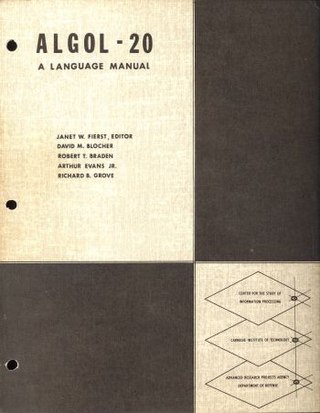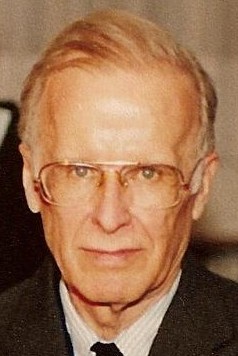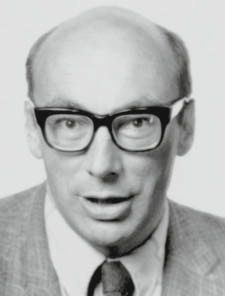Related Research Articles

ALGOL is a family of imperative computer programming languages originally developed in 1958. ALGOL heavily influenced many other languages and was the standard method for algorithm description used by the Association for Computing Machinery (ACM) in textbooks and academic sources for more than thirty years.
CORAL, short for Computer On-line Real-time Applications Language is a programming language originally developed in 1964 at the Royal Radar Establishment (RRE), Malvern, Worcestershire, in the United Kingdom. The R was originally for "radar", not "real-time". It was influenced primarily by JOVIAL, and thus ALGOL, but is not a subset of either.

Sir Charles Antony Richard Hoare is a British computer scientist who has made foundational contributions to programming languages, algorithms, operating systems, formal verification, and concurrent computing. His work earned him the Turing Award, usually regarded as the highest distinction in computer science, in 1980.

John Warner Backus was an American computer scientist. He directed the team that invented and implemented FORTRAN, the first widely used high-level programming language, and was the inventor of the Backus–Naur form (BNF), a widely used notation to define syntaxes of formal languages. He later did research into the function-level programming paradigm, presenting his findings in his influential 1977 Turing Award lecture "Can Programming Be Liberated from the von Neumann Style?"

Peter John Landin was a British computer scientist. He was one of the first to realise that the lambda calculus could be used to model a programming language, an insight that is essential to the development of both functional programming and denotational semantics.
ALGOL 60 is a member of the ALGOL family of computer programming languages. It followed on from ALGOL 58 which had introduced code blocks and the begin and end pairs for delimiting them, representing a key advance in the rise of structured programming. ALGOL 60 was one of the first languages implementing function definitions. ALGOL 60 function definitions could be nested within one another, with lexical scope. It gave rise to many other languages, including CPL, PL/I, Simula, BCPL, B, Pascal, and C. Practically every computer of the era had a systems programming language based on ALGOL 60 concepts.

Roger D. Moore was the 1973 recipient of the Grace Murray Hopper Award from the Association for Computing Machinery (ACM). It was given "for their work in the design and implementation of APL\360, setting new standards in simplicity, efficiency, reliability and response time for interactive systems."

The history of programming languages spans from documentation of early mechanical computers to modern tools for software development. Early programming languages were highly specialized, relying on mathematical notation and similarly obscure syntax. Throughout the 20th century, research in compiler theory led to the creation of high-level programming languages, which use a more accessible syntax to communicate instructions.
Elliott ALGOL is a compiler for the programming language ALGOL 60, for the Elliott 803 computer made by Elliott Brothers in the United Kingdom. It was implemented by Tony Hoare and others. It differed slightly from the reference version of ALGOL, particularly in the supported character set. First released in February 1962, it is believed to be the first implementation of an ALGOL 60 compiler in a commercial context and was an unexpectedly popular product for the company.

Elliott Brothers (London) Ltd was an early computer company of the 1950s–60s in the United Kingdom. It traced its descent from a firm of instrument makers founded by William Elliott in London around 1804. The research laboratories were originally set up in 1946 at Borehamwood and the first Elliott 152 computer appeared in 1950.
S-algol is a computer programming language derivative of ALGOL 60 developed at the University of St Andrews in 1979 by Ron Morrison and Tony Davie. The language is a modification of ALGOL to contain orthogonal data types that Morrison created for his PhD thesis. Morrison would go on to become professor at the university and head of the department of computer science. The S-algol language was used for teaching at the university at an undergraduate level until 1999. It was also the language taught for several years in the 1980s at a local school in St. Andrews, Madras College. The computer science text Recursive Descent Compiling describes a recursive descent compiler for S-algol, implemented in S-algol.

The Elliott 803 is a small, medium-speed transistor digital computer which was manufactured by the British company Elliott Brothers in the 1960s. About 211 were built.
PL360 is a system programming language designed by Niklaus Wirth and written by Wirth, Joseph W. Wells Jr., and Edwin Satterthwaite Jr. for the IBM System/360 computer at Stanford University. A description of PL360 was published in early 1968, although the implementation was probably completed before Wirth left Stanford in 1967.

Peter William O'Hearn, formerly a research scientist at Meta, is a Distinguished Engineer at Lacework and a Professor of Computer science at University College London (UCL). He has made significant contributions to formal methods for program correctness. In recent years these advances have been employed in developing industrial software tools that conduct automated analysis of large industrial codebases.

Anne Wignall, known as Lady Ebury, was an English socialite and author as Alice Acland and Anne Marreco.
Susan Bond, was a scientific officer and computer programmer for the Mathematics Division of the Royal Radar Establishment (RRE) in the United Kingdom. She worked extensively on the programming language ALGOL 68 and the Royal Radar Establishment Automatic Computer (RREAC), an early solid-state electronics, ICL 1907F computer.
Dennis Nicholas Herbert Herbert, 3rd Baron Hemingford,, known professionally as Nick Herbert, was a British peer and journalist who collaborated with publications such as The Times and the Cambridge Evening News.
References
- 1 2 Hoare, C. A. R.; Jones, C. B. (1989). Essays in computing science. New York: Prentice Hall. p. 5. ISBN 9780132840279 . Retrieved 17 January 2023.
- ↑ Mosley, Charles, ed. (2003). Burke's Peerage, Baronetage & Knightage (107 ed.). Wilmington, Delaware: Burke's Peerage (Genealogical Books) Ltd. p. 3232. ISBN 9780971196629.
- ↑ Perruso, Alison (17 December 2012). Who's Who in the World 2013. Marquis Who's Who. ISBN 9780837911502 . Retrieved 17 January 2023– via Internet Archive.
- 1 2 3 "Interview with Jill Hoare, former programmer for Elliott Brothers and the NHS". University of Oxford Podcasts. 6 October 2018. Retrieved 17 January 2023.
- ↑ Lavington, Simon (14 January 2022). Moving Targets: Elliott-Automation and the Dawn of the Computer Age in Britain, 1947 – 67. Springer. Retrieved 17 January 2023– via Internet Archive.